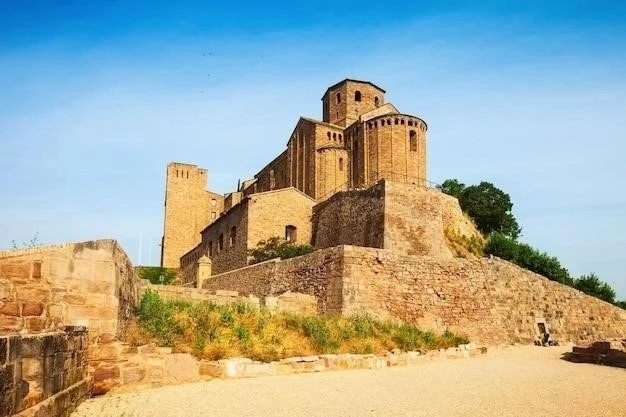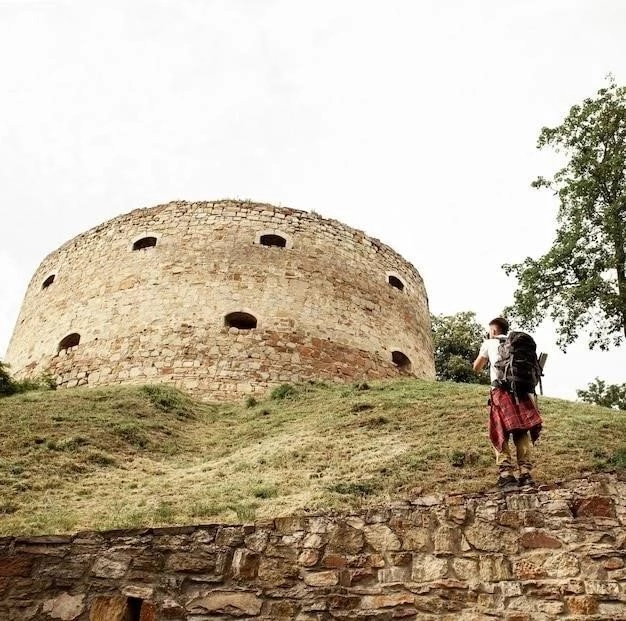Nestled amidst the majestic Sahyadri mountain range in Maharashtra‚ India‚ Lohagad Fort stands as a testament to the regions rich history and architectural prowess. Its strategic location‚ perched atop a hill at an elevation of 1‚033 meters (3‚389 feet) above sea level‚ offers breathtaking panoramic views of the surrounding valleys and neighboring Visapur Fort.
Etymology and Significance of the Name
The name “Lohagad” is derived from the Marathi words “loha” meaning iron and “gad” meaning fort. True to its name‚ the fort was renowned for its impregnable defenses and strategic importance throughout history. Its imposing structure‚ constructed using locally sourced black basalt rock‚ made it a formidable stronghold against enemy forces.
A Journey Through Time: History of Lohagad Fort
Early History and Construction
While the exact origins of Lohagad Fort remain shrouded in the mists of time‚ historical accounts suggest that the site may have been occupied as early as the 12th century. Some historians attribute the initial construction to Raja Bhoj of the Shilahara dynasty. However‚ it was during the reign of the Yadava dynasty in the 14th century that Lohagad gained prominence as a strategically important fortification.
The Mughal-Maratha Struggle
In the 16th century‚ Lohagad Fort fell under the control of the Bahmani Sultanate and subsequently became a part of the Ahmadnagar Sultanate. The fort witnessed a period of significant upheaval during the Mughal-Maratha conflicts of the 17th century. In 1648‚ the legendary Maratha warrior king‚ Chhatrapati Shivaji Maharaj‚ captured Lohagad from the Mughals‚ marking the beginning of its association with the Maratha Empire.
Lohagad Under Shivaji Maharaj
Shivaji Maharaj recognized the strategic significance of Lohagad and strengthened its defenses to secure his newly acquired territories. The fort served as a crucial military outpost‚ protecting the vital trade routes that passed through the region. It was also used as a treasury to store the Maratha armys wealth and provisions.
The Treaty of Purandar and Mughal Rule
In 1665‚ under the terms of the Treaty of Purandar‚ Shivaji Maharaj was forced to cede Lohagad and several other forts to the Mughal emperor Aurangzeb. The Mughals held control of the fort for a brief period‚ during which they made some modifications to its structure.
Maratha Recapture and the Peshwa Era
In 1670‚ Shivaji Maharaj recaptured Lohagad from the Mughals‚ and it remained under Maratha control until the rise of the Peshwas in the 18th century. The Peshwas‚ who served as the prime ministers of the Maratha Empire‚ further expanded and fortified Lohagad‚ making it one of their most important strongholds.
British Conquest and the End of an Era
In 1818‚ during the Third Anglo-Maratha War‚ Lohagad Fort fell into the hands of the British East India Company. The British recognized the forts strategic value and maintained it as a military outpost until Indias independence in 1947.
Architectural Marvel: Exploring the Forts Structure
Lohagad Fort is renowned for its impressive architecture‚ characterized by its robust construction‚ intricate carvings‚ and strategic design elements. The forts main entrance‚ known as the “Maha Darwaza” or the Great Gate‚ is an imposing structure that leads into a series of courtyards‚ each with its unique features and purpose.
Key Architectural Features
- Maha Darwaza (Great Gate): The main entrance to the fort‚ adorned with intricate carvings and flanked by two massive bastions.
- Hanuman Gate: A smaller gate located on the western side of the fort‚ believed to have been built by the Mughals.
- Citadel: The highest point of the fort‚ housing the ruins of palaces‚ temples‚ and other important structures.
- Water Tanks: Several large water tanks‚ including the “Scotsmans Tank‚” were built to ensure a constant supply of water for the forts inhabitants.
- Secret Tunnels: Legend has it that the fort is connected to Visapur Fort by a network of secret tunnels‚ although their existence remains unconfirmed;
Lohagad Today: A Popular Tourist Destination
Today‚ Lohagad Fort stands as a protected monument and a popular tourist destination. Visitors from all over the world come to marvel at its architectural grandeur‚ explore its historical significance‚ and enjoy the breathtaking views from its ramparts.
Trekking to Lohagad Fort
Lohagad Fort is a popular trekking destination‚ particularly during the monsoon season when the surrounding hills are cloaked in lush greenery. The trek to the fort is considered relatively easy and can be completed in about 1-2 hours. The trail winds its way through dense forests‚ offering glimpses of the forts imposing structure along the way.
Tips for Visiting Lohagad Fort
- The best time to visit Lohagad Fort is during the monsoon season (June to September) when the weather is pleasant and the surroundings are green.
- Wear comfortable shoes suitable for trekking.
- Carry sufficient water and snacks‚ as there are no shops or restaurants at the fort.
- Respect the historical significance of the site and refrain from littering or damaging the structures.
- Engage a local guide to enhance your experience and learn more about the forts history.
Conclusion
Lohagad Fort stands as a testament to Indias rich history‚ architectural ingenuity‚ and strategic brilliance. Its imposing structure‚ perched atop a hill‚ has witnessed the rise and fall of empires‚ the clash of cultures‚ and the enduring spirit of human resilience. Today‚ it serves as a reminder of the past and a beacon of hope for the future‚ inspiring awe and wonder in all who visit its hallowed grounds.

Legacy of Strategic Significance
Lohagads strategic importance extended beyond its robust construction. Its elevated position offered a commanding view of the surrounding valleys and trade routes‚ making it a crucial element in controlling the regions economic and military activities. The forts design incorporated natural defensive features‚ such as steep slopes and dense vegetation‚ further enhancing its impregnability.
A Glimpse into the Past: Notable Structures
Within Lohagads fortified walls lie remnants of a vibrant past. The Dargah or tomb near the Maha Darwaza offers a glimpse into the forts diverse cultural influences. The remnants of granaries and storehouses speak to Lohagads role as a vital supply depot for the Maratha army. The Vinchu Kata or Scorpions Sting‚ a narrow‚ winding pathway leading to the top‚ showcases the forts ingenious defensive design‚ intended to slow down advancing enemy forces.
Preservation and Conservation Efforts
Recognizing Lohagads historical and architectural significance‚ the Archaeological Survey of India (ASI) has designated it a protected monument. Conservation efforts are ongoing to preserve the forts structural integrity and prevent further deterioration. These efforts include restoration of damaged walls‚ preservation of ancient inscriptions‚ and management of vegetation growth to minimize damage to the structures.
Lohagad Fort: A Symbol of Resilience and Ingenuity
More than just a historical relic‚ Lohagad Fort stands as a symbol of resilience‚ ingenuity‚ and strategic brilliance. Its enduring presence serves as a reminder of the regions tumultuous past‚ the ambition of empires‚ and the legacy of those who built and defended its formidable walls. Today‚ Lohagad continues to captivate visitors with its grandeur‚ offering a unique opportunity to step back in time and connect with the echoes of history.
Lohagad Fort: A Synthesis of Military Architecture and Natural Splendor
Beyond its historical significance‚ Lohagad Fort stands as a testament to the ingenuity of military architecture harmonizing with the natural landscape. The forts strategic placement atop a steep incline‚ coupled with the utilization of natural defensive features like cliffs and dense foliage‚ made it a formidable bastion against enemy advances. This integration of nature and design is a hallmark of many hill forts in the region‚ but Lohagad stands out for its sheer scale and the effectiveness of its defenses.
Water Management: A Testament to Engineering Prowess
A crucial aspect of Lohagads resilience lay in its sophisticated water management system. The forts engineers devised a network of tanks and cisterns to collect and store rainwater‚ ensuring a year-round supply for its inhabitants. This foresight proved invaluable during prolonged sieges‚ enabling the fort to withstand extended periods of isolation. The most notable of these water bodies‚ the Scotsmans Tank‚ is an impressive example of ancient water harvesting techniques‚ showcasing the advanced engineering skills of the Maratha era.
A Window into the Past: Archaeological Significance
Lohagad Fort is not only a visual spectacle but also an archaeological treasure trove. Excavations within the forts precincts have unearthed artifacts like pottery shards‚ coins‚ and weapons‚ providing valuable insights into the lives of the people who lived and worked within its walls. These findings offer glimpses into the daily routines‚ cultural practices‚ and economic activities of the bygone era‚ enriching our understanding of the forts historical context.
Conservation Challenges and Sustainable Tourism
Preserving Lohagad Fort for future generations presents ongoing challenges. The impact of weathering‚ erosion‚ and increasing tourist footfall requires careful management. Conservation efforts focus on striking a balance between preserving the forts authenticity and providing access to visitors. Sustainable tourism practices‚ such as controlled visitor flow‚ waste management initiatives‚ and raising awareness about the sites fragility‚ are crucial to ensuring that Lohagad Fort continues to inspire awe and wonder for generations to come.
Lohagad: An Enduring Legacy
Lohagad Fort stands as a proud emblem of Indias rich historical tapestry‚ its legacy interwoven with tales of valor‚ strategic brilliance‚ and architectural ingenuity. As a protected monument‚ it serves as a beacon‚ drawing visitors and scholars alike to delve into its multifaceted history. The forts enduring presence serves as a constant reminder of the past‚ urging us to reflect upon the lessons of history while inspiring future generations to safeguard our shared heritage.
Lohagad Fort: Enduring Symbol of Maharashtras Heritage
Lohagad Fort‚ a formidable stone sentinel rising from the Sahyadri range‚ embodies the spirit of Maharashtras rich history. More than just a military outpost‚ it stands as a testament to architectural brilliance‚ strategic prowess‚ and the enduring legacy of the Maratha empire. This article delves deeper into the forts multifaceted significance‚ exploring its lesser-known aspects and their relevance in contemporary times.
Architectural Nuances: A Symphony in Stone
Lohagads architectural vocabulary goes beyond mere fortification. It reveals a nuanced understanding of terrain‚ material‚ and defensive strategy. The use of locally sourced basalt and lime mortar not only ensured structural integrity but also facilitated seamless integration with the landscape. The forts design incorporates:
- Bastions and Ramparts: strategically placed to provide overlapping fields of fire‚ effectively countering enemy advances.
- Secret Escapes and Tunnels: a testament to the Marathas strategic acumen‚ offering escape routes during times of siege;
- Sculpted Water Cisterns: beyond their practical use‚ these display intricate carvings‚ hinting at the artistic sensibilities of the era.
A Microcosm of History: Beyond the Battlefield
Lohagads historical significance extends beyond military campaigns. It served as a treasury‚ a refuge during political turmoil‚ and a center for administrative activities. This is evident in the remnants of:
- Granaries and Storehouses: highlighting the forts role in sustaining the Maratha army and surrounding population.
- Residential Quarters: indicating the presence of a permanent population‚ including families of soldiers and administrative officials.
- A Mint: evidence suggests the fort housed a mint for a period‚ further underlining its administrative and economic importance.
Lohagad Today: Heritage Preservation and Tourism Potential
Today‚ Lohagad Fort stands as a protected monument under the aegis of the Archaeological Survey of India. Efforts are underway to balance heritage conservation with responsible tourism. This includes:
- Structural Stabilization: using scientifically sound methods to preserve the forts integrity against natural elements.
- Documentation and Research: ongoing efforts to study‚ document‚ and interpret the forts history and architectural features.
- Visitor Management: implementing measures to regulate tourist flow‚ minimize environmental impact‚ and enhance the visitor experience.
Conclusion: A Legacy Etched in Stone
Lohagad Fort‚ with its imposing presence and layered history‚ serves as a potent symbol of Maharashtras heritage. It is a site where the past converses with the present‚ offering valuable lessons in resilience‚ strategic thinking‚ and harmonious coexistence with nature. As we move forward‚ it is our collective responsibility to ensure that this architectural marvel continues to inspire awe and wonder for generations to come.

Lohagad Fort: A Deeper Dive into its Enduring Significance
While Lohagad Fort’s imposing structure and strategic brilliance are readily apparent‚ a deeper exploration reveals a multi-layered narrative woven into its very fabric. This historical gem offers valuable insights into the socio-economic dynamics‚ engineering ingenuity‚ and cultural nuances of the era it represents.
Beyond Defense: A Testament to Socio-Economic Vibrancy
Lohagad was far more than a military stronghold; it functioned as a microcosm of a thriving society. The presence of granaries‚ with their ingenious ventilation systems‚ underscores the forts role in ensuring food security for its inhabitants. The remnants of a marketplace‚ identified through archaeological findings‚ hint at a bustling hub of trade and commerce within the forts walls. This interplay of military might and economic activity paints a picture of a self-sufficient community‚ highlighting the forts significance as a center for regional stability and prosperity.
Engineering Marvels: A Symphony of Innovation and Sustainability
Lohagad stands as a testament to the advanced engineering prowess of the Maratha era. Its builders were acutely aware of the need to withstand prolonged sieges‚ leading them to develop sophisticated solutions for water management and sanitation. The intricate network of cisterns and aqueducts‚ designed to collect and channel rainwater‚ showcases a deep understanding of hydrological principles. Furthermore‚ the construction of stepped wells‚ strategically positioned within the fort‚ ensured access to groundwater even during dry spells. These innovations‚ implemented centuries ago‚ offer valuable lessons in sustainable living and resource management for the modern world.
A Cultural Tapestry: Weaving Together History and Heritage
Lohagads significance extends beyond its physical attributes. It holds a special place in the cultural consciousness of the region‚ its history intertwined with folklore‚ legends‚ and local traditions. The forts association with Chhatrapati Shivaji Maharaj‚ a revered figure in Maharashtrian history‚ adds a layer of reverence and national pride. Moreover‚ the presence of ancient temples within the fort complex‚ dedicated to various deities‚ points to the harmonious coexistence of different faiths and cultural practices. These intangible aspects of Lohagads legacy contribute to its enduring appeal‚ making it a site of pilgrimage‚ cultural exploration‚ and historical reflection.
Lohagad in the 21st Century: Balancing Preservation and Progress
As we navigate the complexities of the 21st century‚ Lohagad Fort stands as a potent reminder of our shared heritage and the importance of its preservation. Striking a balance between conservation efforts and responsible tourism is paramount. This involves implementing sustainable practices that minimize environmental impact while ensuring that future generations can continue to marvel at this architectural and historical treasure. By promoting research‚ fostering community engagement‚ and raising awareness about the forts significance‚ we can ensure that Lohagad continues to inspire awe‚ ignite curiosity‚ and provide valuable insights into our collective past.
Lohagad Fort: A Legacy of Strategic Brilliance and Cultural Significance
Lohagad Fort‚ perched atop a rugged hill in the Sahyadri range of Maharashtra‚ India‚ stands as a testament to the strategic acumen and architectural prowess of the Maratha Empire. More than just a military outpost‚ it represents a confluence of history‚ culture‚ and engineering ingenuity‚ offering invaluable insights into a bygone era.
A Symphony in Stone: Deciphering the Architectural Language of Power
Lohagads design transcends mere fortification. It reveals a nuanced understanding of terrain‚ material‚ and defensive strategy. The use of locally sourced basalt and lime mortar not only ensured structural integrity but also facilitated seamless integration with the landscape. The forts design incorporates:
- Bastions and Ramparts: strategically placed to provide overlapping fields of fire‚ effectively countering enemy advances.
- Secret Escapes and Tunnels: a testament to the Marathas strategic acumen‚ offering escape routes during times of siege.
- Sculpted Water Cisterns: beyond their practical use‚ these display intricate carvings‚ hinting at the artistic sensibilities of the era.
Beyond the Bulwarks: Unveiling the Socio-Economic Dynamics of a Fortified City
Lohagads significance extends beyond its military role. It functioned as a microcosm of a thriving society‚ evidenced by the presence of granaries‚ a marketplace (as revealed through archaeological excavations)‚ and residential quarters. This points to a self-sufficient community within the forts walls‚ engaged in trade‚ agriculture‚ and administration. Such insights highlight Lohagads impact on the socio-economic landscape of the region‚ showcasing its role as a center for not just defense‚ but also for commerce and community life.

Echoes of Ingenuity: Water Management and Sustainable Practices
Lohagads builders demonstrated remarkable foresight in ensuring the forts sustainability during prolonged sieges. The intricate network of cisterns and aqueducts‚ designed to harvest and channel rainwater‚ showcases an advanced understanding of hydrology and water management. The presence of strategically located stepped wells‚ tapping into groundwater sources‚ further underscores their commitment to self-sufficiency. These centuries-old innovations offer valuable lessons for modern urban planning and resource management‚ emphasizing the importance of sustainable practices.

A Tapestry of Time: Conservation‚ Research‚ and Responsible Tourism
Today‚ Lohagad stands as a protected monument under the stewardship of the Archaeological Survey of India. Balancing preservation with accessibility is paramount. This involves implementing scientifically sound conservation methods‚ conducting thorough archaeological research to further illuminate the forts history‚ and managing visitor impact to minimize wear and tear on this invaluable heritage site.
Lohagads Enduring Legacy: A Beacon for Future Generations
Lohagad Fort‚ with its imposing presence and multi-layered history‚ offers a glimpse into a pivotal period in Indias past. It serves as a testament to the strategic brilliance‚ architectural ingenuity‚ and cultural dynamism of the Maratha Empire. As we move forward‚ it is our collective responsibility to ensure that this historical treasure continues to inspire awe‚ ignite curiosity‚ and provide valuable insights for generations to come. By supporting conservation efforts‚ promoting responsible tourism‚ and engaging in continued research‚ we can ensure that Lohagads legacy endures‚ standing as a beacon of history and a testament to human ingenuity.










